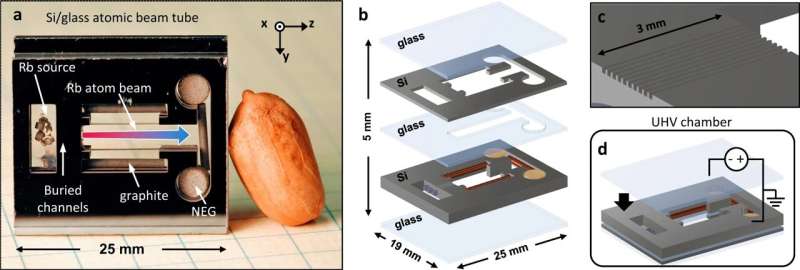This article has been reviewed according to Science X's editorial process and policies. Editors have highlighted the following attributes while ensuring the content's credibility:
fact-checked
peer-reviewed publication
trusted source
proofread
New tiny atomic beam clock could bring stable timing to places GPS can't reach

A new type of miniature atomic clock could provide better timing over the span of weeks and months compared with current systems. Researchers at the National Institute of Standards and Technology (NIST), in collaboration with researchers from Georgia Tech, have made the first-of-its-kind chip-scale beam clock. Their work has been published in Nature Communications.
Atomic clocks take many forms, but the oldest and one of the most prominent designs is built using atomic beams. These clocks send a beam of atoms through a vacuum chamber. At one end of the chamber, the atoms are set in a specific quantum state, and they start "ticking." At the other end their ticking rate is measured or "read out." Using the atoms' precise ticking rate, other clocks can be compared to atomic beam clocks, and adjusted to match their timing.
NIST has been using atomic beams for timekeeping since the 1950s. For decades, beam clocks were used to keep the primary standard for the second, and they are still part of NIST's national timekeeping ensemble. Beam clocks are precise, stable and accurate, but they're currently not the most portable. The vacuum chambers where the atoms travel are key to the success of these clocks, but they're bulky in part due to the size of the microwave cavity used to probe the atomic "ticking." The vacuum chamber for NIST-7, the last beam clock used for the primary frequency standard in the U.S., was more than 2.5 meters or 8 feet long.
Smaller commercial clocks about the size of a briefcase are common, but they still require a significant amount of power (about 50 watts) to run. For comparison, smartphones require about a third of a watt for typical operation.
Chip-scale atomic clocks (CSACs) were developed by NIST in 2001. Advances in microfabrication techniques let NIST make vapor cells, tiny chambers where the clock's atoms are held and measured, the size of a grain of rice; the entire clock is about the size of a piece of sushi. These clocks consume very little power and can run on batteries to provide timing in critical situations where GPS can't reach.
CSACs have found numerous applications in underwater oil and gas exploration, military navigation, and even telecommunications. However, the clocks' timekeeping tends to drift when temperatures shift and the gas surrounding the atoms degrades.
"The CSAC is low-power and has high performance given its size. It's a wonderful device, but it does drift after running for a few thousand seconds," said William McGehee, a physicist at NIST. "Beam clocks have been around since the 1950s and are stable, but still need a lot of power. What if we could combine the best aspects of these two systems?"
Using microfabrication techniques learned from the CSAC, the group fabricated a chip-scale atomic beam device using a stack of etched silicon and glass layers. This device is a highly miniaturized version of the chambers that have been used in atomic beam clocks like NIST-7 and is about the size of a postage stamp.
Atomic vapor cell construction techniques developed at NIST and etched microcapillary arrays developed at Georgia Tech were key to shrinking the vacuum chambers of larger beam clocks.
In the device, one chamber contains a small pill of rubidium. That chamber heats up, releasing a stream of rubidium atoms through microcapillaries, channels only 100 micrometers wide. Those tiny channels connect to another chamber with materials that can absorb—or collect—individual gas molecules, called non-evaporable getters, or NEGs, which pull the rubidium atoms along and collect them, keeping the vacuum in the microcapillaries clean. Tiny rods of graphite also help collect stray atoms through the process.
Right now, this chip-scale beam device is a prototype for a miniature atomic beam clock. Initial tests of the chip-scale beam clock showed performance at a level slightly worse than existing CSACs, but the team sees a path toward improved stability. The researchers hope to push their precision by another factor of 10, and to exceed the stability of existing CSACs by 100 times over week time scales.
More information: Gabriela D. Martinez et al, A chip-scale atomic beam clock, Nature Communications (2023). DOI: 10.1038/s41467-023-39166-1
Journal information: Nature Communications
Provided by National Institute of Standards and Technology




















